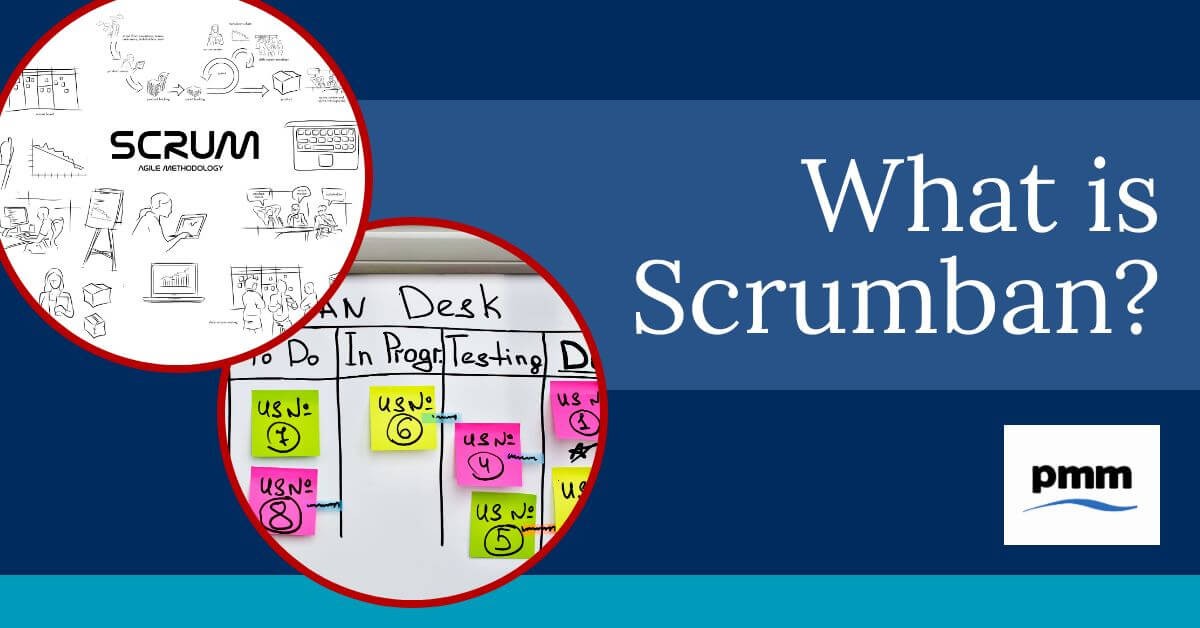Scrumban is a hybrid Agile development methodology which combines the structure of Scrum with the flexibility and visualisation of Kanban.
What is Scrum?
An Agile framework, Scrum facilitates the maximisation of quick delivery, a proactive response to changing requirements and adaptation to new technologies and changes within the market.
Sprints of between one and four weeks are used in the process by small, self-organising and cross-functional Scrum teams.
Work is split into small increments and organised according to priority and relative effort. The Product Owner then selects which items will be completed during the sprint.
More details of Scrum can be found by visiting Scrum Master Role.
What is Kanban?
A visual workflow management, Kanban represents work items by using cards on a board. The board has three lanes which represent, backlog, doing and done, and each work item moves through the lanes.
When using Kanban, the project team plan, work, review and measure their work outcomes using a continuous flow approach, in contrast to the defined sprints of Scrum. To ensure that the project team aren’t overloaded with work items, Kanban limits how many items are in the process at any one time by identifying the work in process limits.
To achieve the desired continuous and predictable flow, Kanban measures and improves lead time by optimising processes.
More details of Kanban can be found by visiting Overview of Kanban Process for Project Management.
How do they combine?
Scrumban is achieved by combining Scrum’s structure and Kanban’s process improvement.
Aspects of Scrum used to achieve this are:
- Regular iteration planning, reviews and retrospectives.
- Identification of the amount of work that can be pulled into the sprint, based upon the complexity and length of sprint.
- On-demand prioritisation.
- A sound definition of ready.
- Facilitating organisation of work by using the ready queue, between backlog and doing.
Aspects of Kanban used are:
- Pulling items into doing when the team has capacity.
- Limits as to how many items are actively in progress.
- No specified individual roles.
- Emphasis on just-in-time analysis and planning, producing short lead times.
- Flow charts and process buffers to identify weaknesses and improvement opportunities.
- Greater focus on cycle time.
- Process step transitions made clearer by policies.
Why use Scrumban?
If Scrum is too structured for your project, and Kanban too free-flowing, then Scrumban could be a great solution.
Scrumban is also a useful methodology for teams who aim to make the transition from Scrum to Kanban. Transitioning straight from Scrum to Kanban is often too much of a shift, and so moving first to Scrumban provides a way of learning Kanban within a familiar working structure.
Advantages of Scrumban
There are many advantages of using Scrumban, such as:
Saves time
Planning only takes place when there is a demand for it as opposed to regular sprint planning, thus saving time.
Compartmentalisation
On larger projects where there are more tasks and deliverables required, Scrumban can distribute time and prioritise work into shorter iterations to better manage large projects.
Identify bottlenecks
Bottlenecks slow work down, disrupt schedules and waste both money and time. Bottlenecks can be identified more easily with Scrumban due to its visual nature, allowing managers to spot them before they become an issue.
Transparency
The visual nature of Scrumban allows all team members to see where they are and where the project is up to. Updates are seen by the whole team.
Independence
In Scrumban, team members are equal which creates an environment with less stress. Teams are given autonomy to choose which tasks to pull through from backlog to doing when they have capacity, rather than having them assigned by a project manager.
Disadvantages of Scrumban
Of course, as with any other Project Management method or tool, Scrumban does have some disadvantages.
New concept
As Scrumban is a relatively new concept, there are no best practices for using it. This can result in it being used differently across teams with no standardisation.
Difficult to track
In Scrumban teams choose which task they work on, and so it can be difficult to track individual team member’s contribution and efforts.
Loss of control
Although the Project Manager has long-term control over the process, once the tasks have been identified and prioritised it is the project team who handle and implement them.
As there are no daily scrum meetings the Project Manager doesn’t get an overview of progress as it happens.
Overall Scrumban is an effective framework for teams to adopt, particularly if they are in the process of transitioning from Scrum to Kanban.
Although it has some disadvantages, it’s advantages are plentiful both for the project team, who are given more freedom and autonomy over their workload, and the Project Manager who isn’t required to manage the project as closely.
